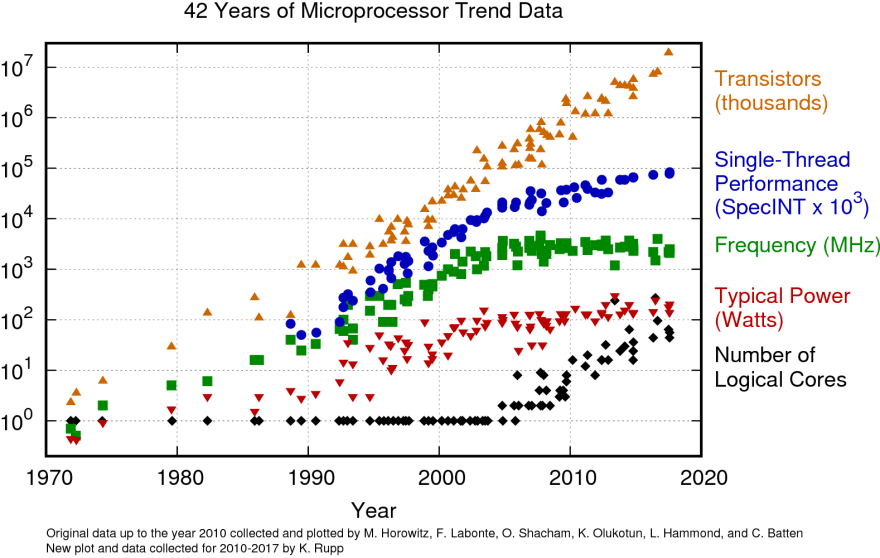Would you like to see the future? This post aims at predicting what will happen to the field of Deep Learning. Scroll on.
Microprocessor Trends
Who doesn’t like to see the real cause of trends?
“Get Twice the Power at a Constant Price Every 18 months”
Some people have said that Moore’s Law was coming to an end. A version of this law is that every 18 months, computers have 2x the computing power than before, at a constant price. However, as seen on the chart, it seems like improvements in computing got to a halt between 2000 and 2010.
See the Moore’s Law Graph
But the Growth Stalled…
This halt is in fact that we’re reaching the limit size of the transistors, an essential part in CPUs. Making them smaller than this limit size will introduce computing errors, because of quantic behavior. Quantum computing will be a good thing, however it won’t replace the function of classical computers as we know them today.
Faith isn’t lost: invest in parallel computing
Moore’s Law isn’t broken yet on another aspect: the number of transistors we can stack in parallel. This means that we can still have a speedup of computing when doing parallel processing. In simpler words: having more cores. GPUs are growing towards this direction: it’s fairly common to see GPUs with 2000 cores in the computing world, already.
That means Deep Learning is a good bet
Luckily for Deep Learning, it comprise matrix multiplications. This means that deep learning algorithms can be massively parallelized, and will profit from future improvements from what remains of Moore’s Law.
 See also: Awesome Deep Learning Resources
See also: Awesome Deep Learning Resources
The AI Singularity in 2029
A prediction by Ray Kurtzweil
Ray Kurtzweil predicts that the singularity will happen in 2029. That is, as he defines it, the moment when a 1000$ computer will contain as much computing power as the brain. He is confident that this will happen, and he insists that what needs to be worked on to reach true singularity is better algorithms.
“We’re limited by the algorithms we use”
So we’d be mostly limited by not having found the best mathematical formulas yet. Until then, for learning to properly take place using deep learning, one needs to feed a lot of data to deep learning algorithms.
We, at Neuraxio, predict that Deep Learning algorithms built for time series processing will be something very good to build upon to get closer to where the future of deep learning is headed.
Big Data and AI
Yes, this keyword is so 2014. It still holds relevant.
“90% of existing data was created in the last 2 years”
It is reported by IBM New Vantage that 90% of the financial data was accumulated in the past 2 years. That’s a lot. At this rate of growth, we’ll be able to feed deep learning algorithms abundantly, more and more.
“By 2020, 37% of the information will have a potential for analysis”
That is what The Guardian reports, according to big data statistics from IDC. In contrast, only 0.5% of all data was analyzed in 2012, according to the same source. Information is more and more structured, and organization are now more conscious of tools to analyze their data. This means that deep learning algorithms will soon have access to the data more easily, wheter the data is stored locally or in the cloud.
It’s about intelligence.
Is about what defines us humans compared to all previous species: our intelligence.
The key of intelligence and cognition is a very interesting subject to explore and is not yet well understood. Technologies related to this field are are promising, and simply, interesting. Many are driven by passion.
On top of that, deep learning algorithms may use Quantum Computing and will apply to machine-brain interfaces in the future. Trend stacking at its finest: a recipe for success is to align as many stars as possible while working on practical matters.
Conclusion
First, Moore’s Law and computing trends indicate that more and more things will be parallelized. Deep Learning will exploit that.
Second, the AI singularity is predicted to happen in 2029 according to Ray Kurtzweil. Advancing Deep Learning research is a way to get there to reap the rewards and do good.
Third, data doesn’t sleep. More and more data is accumulated every day. Deep Learning will exploit that.
Finally, deep learning is about intelligence. It is about technology, it is about the brain, it is about learning, it is about what defines humans compared to all previous species: their intelligence. Curious people will know their way around deep learning.
If you liked this article, consider following us for more!






Top comments (0)